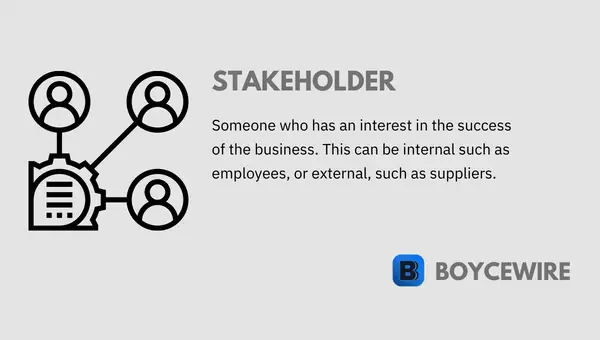Stakeholder: Definition, Internal, External & Examples

What is a Stakeholder
A stakeholder is an individual or entity that has an interest in a business because its decisions affect them. For example, an employee is a stakeholder as their wages are dependent on how successful the company is. If the company does well, they may get a pay rise or a bonus. However, if it is making loses – their job may be at risk.
A stakeholder has an interest in the success or failure of a business as it will have a direct or indirect impact on them. This can come firstly in the form of internal stakeholders – those who are under the control of the company. And secondly, external stakeholders – those who are not employed or own the company.
Internal stakeholders include employees, owners, shareholders, and managers. They are simply anyone within the organization. By contrast, external stakeholders include suppliers, governments, customers, trade unions, and creditors. These are people and organizations that are outside of the business.
Key Points
- A stakeholder is any person or entity that has an interest in the success of a business.
- There are two types of stakeholders – internal stakeholders (inside the organization) and external stakeholders (outside the organization).
Types of Stakeholders
There are two main types of stakeholders – internal and external. Internal stakeholders refer to those who have a direct involvement in the company. This may be through employment or ownership.
External stakeholders are those who have an indirect involvement with the company. This may be through a business agreement, an interest in the products, or an interest in its impact on the wider community.
Let us take a look at some examples of these types of stakeholders.
Internal Stakeholder Examples

1. Employees
Employees have a direct interest in how the business performs as it has a consequential impact on them. For instance, if the business is not doing well, employees may be at risk of losing their jobs. When business is good, they may be in line for a nice pay increase or a bonus.
Interest: Job stability and income.
2. Owners
The owners have many interests, but the number one is profit. After all, without profit, the business would not be able to compete. In turn, the owner has an interest in factors that contribute to profit. For example, employee morale and productivity, and the long-term business plan. Is the business investing in the right areas, lowering costs, and improving profit margins.
Interest: Profit, employee morale, business sustainability.
3. Managers
Company management in the form of executive managers and the board of directors have very different incentives from both the owners and employees. Not only do they get a salary, but frequently receive stock options or grants of stocks. That means the incentives do not necessarily line up with that of the other stakeholders. Instead, there is an incentive to increase the price of the firm’s stocks for their financial gain. This can lead to short-term decisions to boost the stock price, at the cost of long-term sustainability.
Interest: Stock price and business performance.
External Stakeholder Examples

1. Customers
Customers are stakeholders in the sense that a business’s decision may impact on their choice and the price they must pay. For example, a firm may decide to cut costs and use lower-quality materials – thereby affecting the final product consumers receive. A stakeholder is a party that has an interest in the business, so anything the business does that affects the price, quantity, or quality of the good will affect them.
Interest: Quality, quantity, and price of goods.
2. Creditors
Another example of an external stakeholder includes creditors. This may range from family and friends to the big Wall Street Banks. They all have an interest in the business because if it fails, they are unlikely to receive their investment back.
Interest: Repayment of debt.
3. Government
The government is stakeholder with an interest in almost every business. First of all, businesses provide employment to the population. This means more people in work, lower benefit payments, and generally, a more content voting population. Second of all, businesses provide new revenue streams through employment as well as corporate taxes. The more people businesses hire, the more it will receive through income tax. And the more money businesses make, the more government takes in corporation taxes.
Interest: Employment and taxes.
4. Local Communities
Some businesses may create spillover effects on the local community. This may come in the form of pollution, traffic, or aesthetically. At the same time, as an external stakeholder, the local community has an interest in positive spill-over effects such as opportunities for employment and a new place to shop.
Interest: Spill-over effects.
5. Suppliers
Suppliers’ interest is purely financial. If the business they are working with is not doing well, it will have an impact on their sales. For instance, Foxconn is a supplier to Apple and would have a direct interest in the number of sales the new iPhone gets. More sales mean more orders and that means more profit.
Interest: Demand for its goods and profits.
Stakeholder vs Shareholder
Stakeholders are people or entities that have an interest in the company and how well it performs. Shareholders also have an interest in the company, but they are a type of stakeholder. A shareholder owns part of the company, whilst a stakeholder may not even work for the company.
They may be external in the form of customers, creditors, and suppliers – or, internal, in the form of employees, managers, and owners. In fact, shareholders are internal stakeholders within the company.
FAQs on Stakeholder
There are internal stakeholder and external stakeholders – examples include:
Internal
1. Employees
2. Owners
3. Managers
External
1. Customers
2. Creditors
3. Government
4. Local Communities
5. Suppliers
A stakeholder is someone who has an interest in the company, whereas a shareholder actually owns the company and is in fact a type of stakeholder.
A stakeholder is anybody who has an interest in the performance of the company. This is because they can directly or indirectly benefit. For example, employees benefit from the business doing well as it may lead to higher bonuses or pay rises. There are also external stakeholders who benefit such as governments that benefit from higher tax receipts.
About Paul
Paul Boyce is an economics editor with over 10 years experience in the industry. Currently working as a consultant within the financial services sector, Paul is the CEO and chief editor of BoyceWire. He has written publications for FEE, the Mises Institute, and many others.

Further Reading
 Intrinsic Value - Intrinsic value refers to the underlying or inherent worth of an asset, based on its fundamental characteristics and cash flow…
Intrinsic Value - Intrinsic value refers to the underlying or inherent worth of an asset, based on its fundamental characteristics and cash flow…  Degrees of Freedom - Degrees of freedom refers to the number of independent variables or data points that can vary in statistical analysis.
Degrees of Freedom - Degrees of freedom refers to the number of independent variables or data points that can vary in statistical analysis.  Effective Annual Rate - The Effective Annual Rate (EAR) is the true annual interest rate that takes into account compounding effects, providing an accurate…
Effective Annual Rate - The Effective Annual Rate (EAR) is the true annual interest rate that takes into account compounding effects, providing an accurate… 